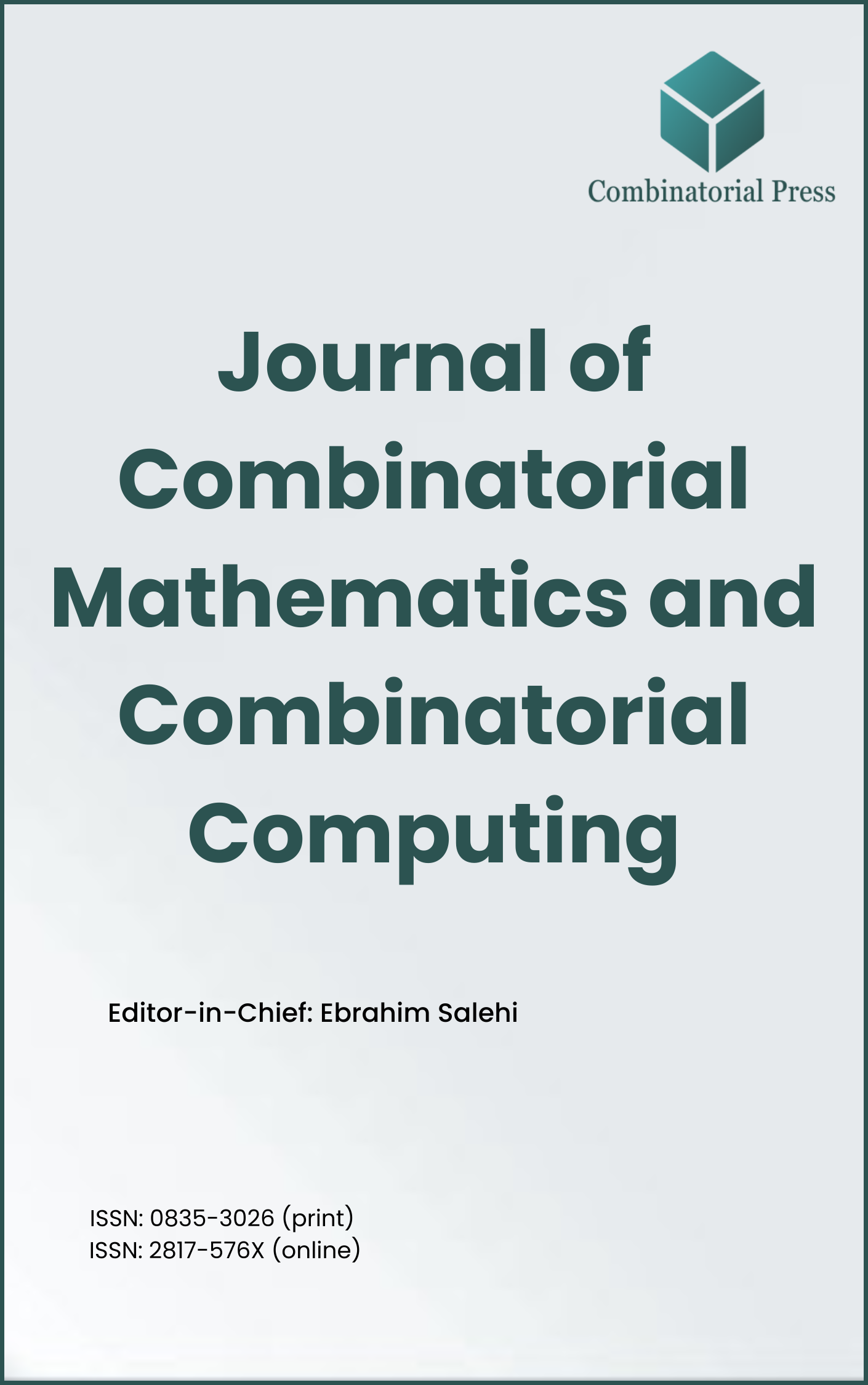
Journal of Combinatorial Mathematics and Combinatorial Computing
ISSN: 0835-3026 (print) 2817-576X (online)
The Journal of Combinatorial Mathematics and Combinatorial Computing (JCMCC) embarked on its publishing journey in April 1987. From 2024 onward, it publishes four volumes per year in March, June, September and December. JCMCC has gained recognition and visibility in the academic community and is indexed in renowned databases such as MathSciNet, Zentralblatt, Engineering Village and Scopus. The scope of the journal includes; Combinatorial Mathematics, Combinatorial Computing, Artificial Intelligence and applications of Artificial Intelligence in various files.
- Research article
- https://www.doi.org/10.61091/jcmcc124-28
- Full Text
- Journal of Combinatorial Mathematics and Combinatorial Computing
- Volume 124
- Pages: 429-443
- Published Online: 18/03/2025
The rise of digital humanities reflects a paradigm shift in literary research. This project applies natural language processing to ancient Chinese literature, embedding an attention mechanism into an iterative null convolutional network for named entity recognition. It also integrates the MacBERT pre-training model with a dual-channel structure of aspectual word and semantic features, designing a hierarchical attention mechanism for aspect-level sentiment analysis. Experimental results show improved recognition and sentiment analysis performance, with evaluation scores exceeding 83%. In Ming Dynasty fiction, craftsmen (44.7%) and merchants (22.4%) were the most frequent characters, highlighting the rise of a commercial economy and civic class. In Tang Dynasty poetry, 67.9% of sentiments were positive, with themes of national honor (0.334) and send-off emotions (0.226) commonly linked, reflecting the era’s prosperity and literary aspirations.
- Research article
- https://www.doi.org/10.61091/jcmcc124-27
- Full Text
- Journal of Combinatorial Mathematics and Combinatorial Computing
- Volume 124
- Pages: 409-427
- Published Online: 18/03/2025
The family of graphs of reduced words of a certain sub-collection of permutations in the union
- Research article
- https://doi.org/10.61091/jcmcc124-26
- Full Text
- Journal of Combinatorial Mathematics and Combinatorial Computing
- Volume 124
- Pages: 389-407
- Published Online: 18/03/2025
In this paper, we introduce the concept of the Over-inversion number, which counts the overlined permutations of length
- Research article
- https://doi.org/10.61091/jcmcc124-25
- Full Text
- Journal of Combinatorial Mathematics and Combinatorial Computing
- Volume 124
- Pages: 377-387
- Published Online: 18/03/2025
This paper aims at resolving the issue that the conventional literature study can’t deal with the large amount of data, the author proposes a research method for theme clustering and text mining of Chinese modern and contemporary literary texts in the network era. The author studied how to effectively improve the thematic clustering performance of literary texts based on keyword clustering ensemble method. Comparing two clustering ensemble methods (K-means based data ensemble and incremental clustering based algorithm ensemble) and four keyword extraction methods (TF-ISF CSI, ECC, TextRank), the effects of various keywords on the results of thematic clustering were analysed. Experiments indicate that the clustering algorithm can greatly increase the topic clustering efficiency, and it is more stable when the key words are less. The author’s research provides new technological means for text mining and thematic clustering in contemporary Chinese literature, which helps to promote the development of digital humanities research.
- Research article
- https://doi.org/10.61091/jcmcc124-24
- Full Text
- Journal of Combinatorial Mathematics and Combinatorial Computing
- Volume 124
- Pages: 351-375
- Published Online: 18/03/2025
The undifferentiated recommendations in current library management systems fail to meet the diverse and personalized needs of users, and the vast amounts of user data accumulated over the years remain largely untapped. This paper integrates personalized recommendation requirements in self-service libraries with K-means clustering to design a labeling system and set user profile weights. Building on traditional reinforcement learning, we propose an Actor–Critic based recommendation algorithm that models the library recommendation task as a Markov decision process to automatically learn an optimal strategy by maximizing expected long-term rewards. The DDPG algorithm is employed to train the parameters of this framework, achieving improved personalized performance. Comparative experiments on datasets (ML-100k, Yahoo! Music, ML-1M, and Jester) demonstrate that our model outperforms traditional methods and DeepFM, with scores of 0.7708, 0.1918, 0.7155, and 0.3936, respectively. This study provides innovative insights for accurate recommendations and enhanced user experience in libraries.
- Research article
- https://www.doi.org/10.61091/jcmcc124-23
- Full Text
- Journal of Combinatorial Mathematics and Combinatorial Computing
- Volume 124
- Pages: 333-349
- Published Online: 17/03/2025
The application of virtual reality (VR) technology in teaching is increasingly widespread. This study leverages VR to create cross-cultural teaching contexts and develop speech recognition models for language learning. An ecological model of language learning based on VR is constructed, and a cross-cultural contextual VR system is implemented and introduced into language education. Testing reveals that the system achieves a speech recognition efficiency of 99.7% and a correctness rate of 99.5%. Moreover, a comparison of pre- and post-test data between experimental and control groups shows that the experimental group significantly outperformed the control group in English proficiency (p < 0.05). Overall, the cross-cultural contextual VR system demonstrates a significant positive impact on language learning outcomes.
- Research article
- https://doi.org/10.61091/jcmcc124-22
- Full Text
- Journal of Combinatorial Mathematics and Combinatorial Computing
- Volume 124
- Pages: 317-331
- Published Online: 17/03/2025
New media advertising boosts platform revenue, and intelligent content optimization enhances its effectiveness. This paper applies a multi-task deep learning neural network to optimize advertisement content, leveraging attention mechanisms and loss functions to improve performance. Blockchain technology is integrated to create a personalized and accurate recommendation system. Experimental results show that the proposed model effectively optimizes ad content, meeting functional and performance requirements. Most users’ ad browsing duration exceeds 50 seconds, outperforming traditional recommendation systems. The proposed system offers strong targeting, fast results, and cost efficiency, significantly enhancing user engagement with ad content.
- Research article
- https://www.doi.org/10.61091/jcmcc124-21
- Full Text
- Journal of Combinatorial Mathematics and Combinatorial Computing
- Volume 124
- Pages: 303-315
- Published Online: 17/03/2025
With the frequent occurrence of global climate change and extreme weather events, meteorological forecasting technology has gradually become an auxiliary technology for production activities. In order to improve the quality of meteorological analysis results, a technology utilizing cloud radar data as the core is proposed. The vertical distribution of water vapor and liquid water in the atmosphere is detected by a ground-based microwave radiometer. The median filtering method is used to further smooth the classified and preliminarily removed reflectance factor data, and computer information processing technology is used for data analysis. The experimental results of Taiyuan ground based remote sensing high altitude detection experiment showed that in the data availability test, the research method had a data availability rate of 97.3% when the height was 2km in humidity data. When conducting accuracy analysis of the results, the root mean square error of the relative humidity profile was only 22.0% when the height increased to 12km. This indicates that the research method can conduct high-quality meteorological analysis and provide assistance for meteorological forecasting.
- Research article
- https://doi.org/10.61091/jcmcc124-20
- Full Text
- Journal of Combinatorial Mathematics and Combinatorial Computing
- Volume 124
- Pages: 291-301
- Published Online: 17/03/2025
A
- Research article
- https://www.doi.org/10.61091/jcmcc124-19
- Full Text
- Journal of Combinatorial Mathematics and Combinatorial Computing
- Volume 124
- Pages: 277-290
- Published Online: 17/03/2025
A prism fuzzy number is the integration of triangular and trapezoidal fuzzy numbers. In this artifact, the balancing point and the grading value of the prism fuzzy number is defined. By using prism fuzzy number, we were able to infer the Trapezoidal and Triangular fuzzy numbers. A comparative study with the current model is done to corroborate our findings. An enhanced grading technique for evaluating the prism fuzzy numbers is defined. Finally, the application of prism fuzzy numbers to assess student’s interest in higher studies and employment is illustrated using the MATLAB simulation. A statistical analysis is demonstrated using the Python programme with real-life data.





